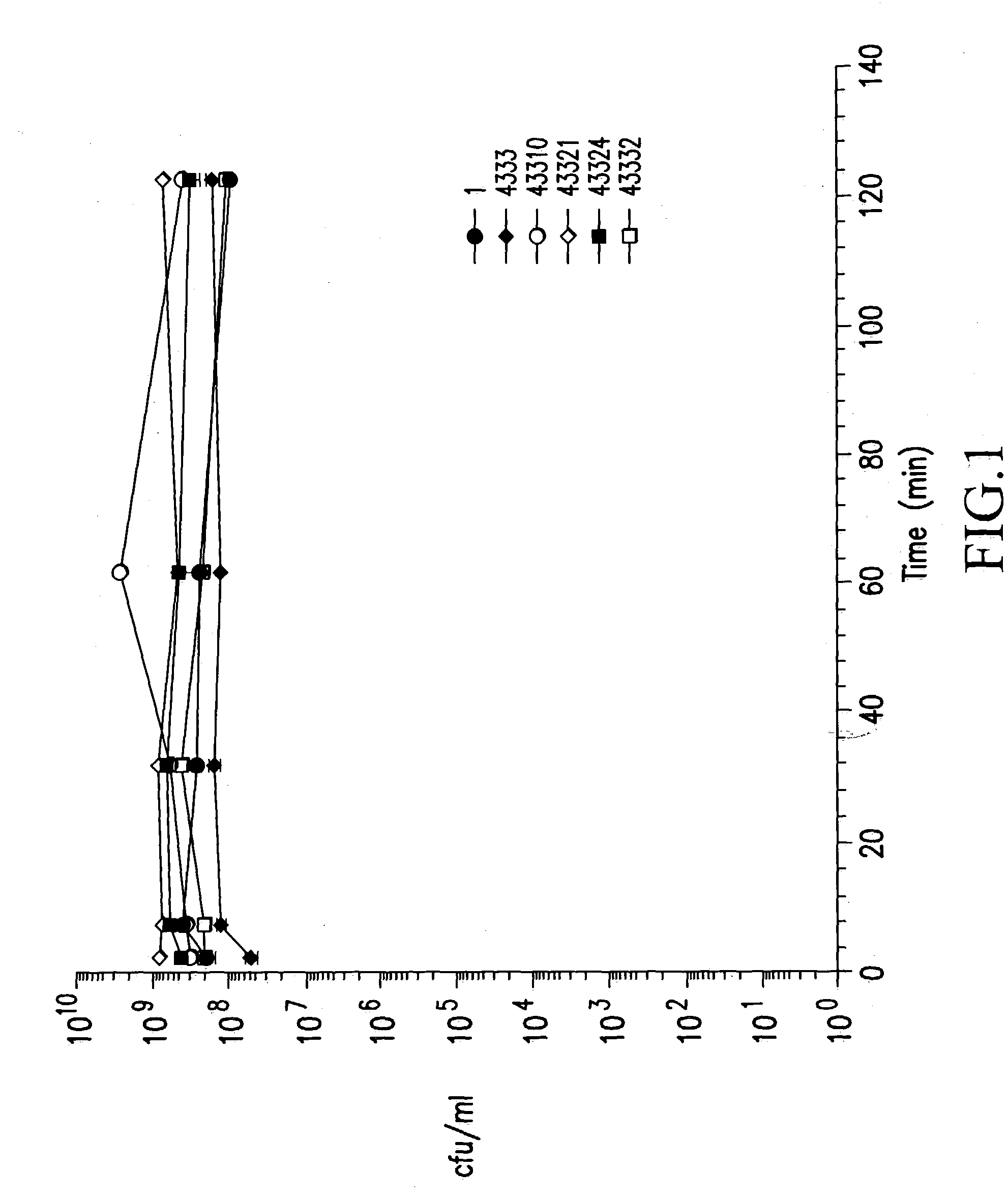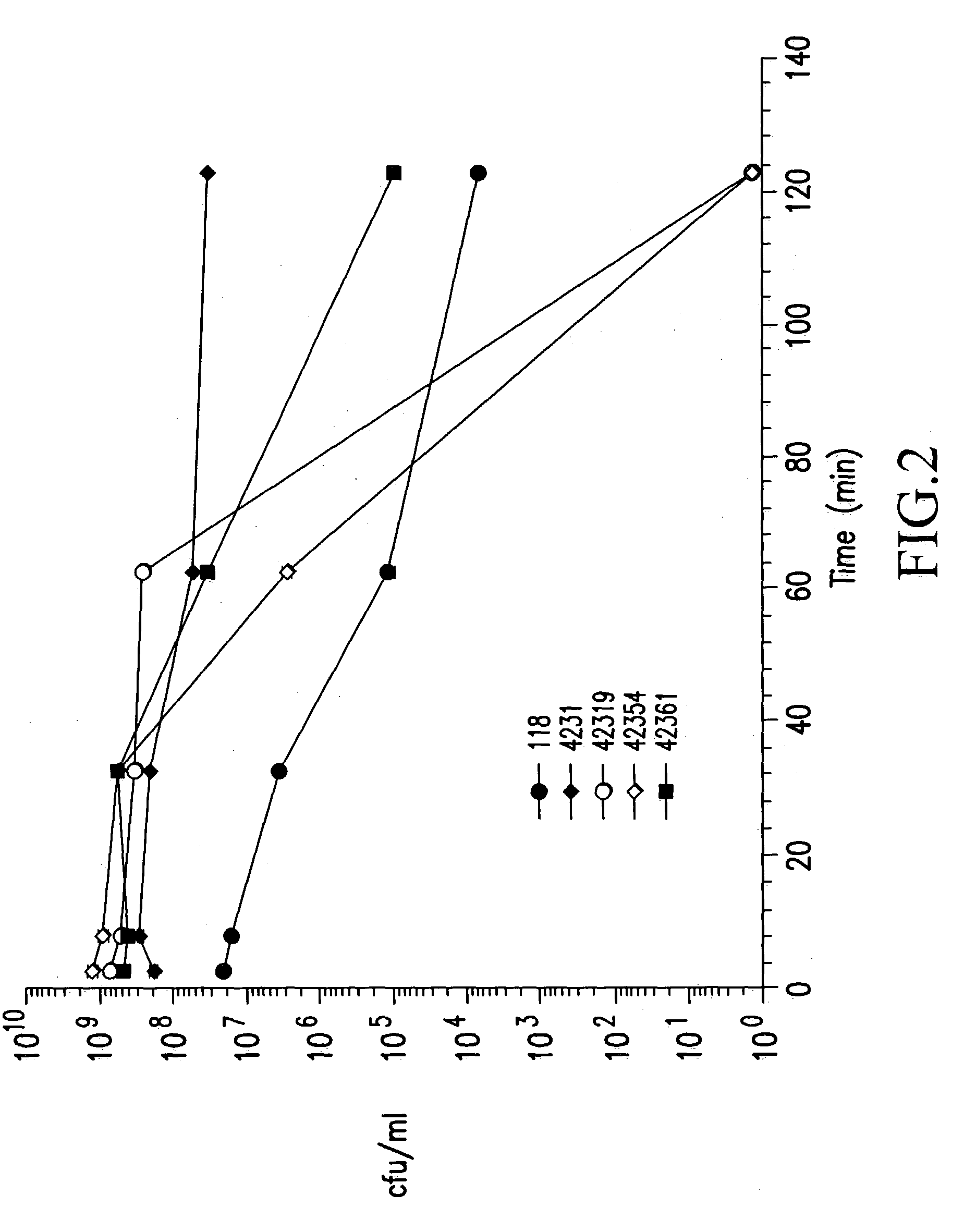Probiotic strains from lactobacillus salivarius and antimicrobial agents obtained therefrom
- Summary
- Abstract
- Description
- Claims
- Application Information
AI Technical Summary
Benefits of technology
Problems solved by technology
Method used
Image
Examples
example 2
[0095] Source and Maintenance of Strains
[0096] The Lactobacillus strains used were isolated as described in Example 1.
[0097] Human Gastric Juice
[0098] Human gastric juice was obtained from healthy subjects by aspiration through a nasogastric tube (Mercy Hospital, Cork, Ireland). It was immediately centrifuged at 13,000 g for 30 min to remove all solid particles, sterilised through 0.45 .mu.m and 0.2 .mu.m filters and divided into 40 ml aliquots which were stored at 4.degree. C. and -20.degree. C.
[0099] The pH and pepsin activity of the samples were measured prior to experimental use. Pepsin activity was measured using the quantitative haemoglobin assay (Gautam, S. and de La Motte, R. S., (1989) Proteolytic enzymes, a practical approach. Chapter 3. R. J. Beynon and J. S. Bond (eds.), IRL Press, Oxford University Press; (Dawson, R. M. (1969) In Data for Biochemical Research 138. R. M. Dawson, D. C. Elliot and K. M. Jones (eds.), Clarendon Press, Oxford). Briefly, aliquots of gastric j...
example 3
[0118] Lactobacillus strains used were isolated as described in Example 1.
[0119] Growth of Cultures in the Presence of Bovine and Porcine Bile
[0120] Fresh cultures were streaked onto MRS / TPY agar plates supplemented with bovine bile (B-8381, Sigma Chemical Co. Ltd., Poole) at concentrations of 0.3, 1.0, 1.5, 5.0 and 7.5% (w / v) and porcine bile (B-8631, Sigma Chemical Co. Ltd., Poole) at concentrations of 0.3, 0.5, 1.0, 1.5, 5.0 and 7.5% (w / v). Plates were incubated at 37.degree. C. under anaerobic conditions and growth was recorded after 24-48 h.
[0121] Growth of Cultures in the Presence of Human Bile
[0122] Bile samples, isolated from several human gall-bladders, were stored at -80.degree. C. before use. For experimental work, bile samples were thawed, pooled and sterilised at 80.degree. C. for 10 min. Bile acid composition of human bile was determined using reverse-phase HPLC in combination with a pulsed amperometric detector according to the method of (Dekker, R. R. et al., (1991) ...
example 4
[0148] Growth and Maintenance of Cultures
[0149] The microorganisms screened for antimicrobial production were the seventeen strains listed in Table 3 and were isolated from the human intesinal tract as described in Example 1. All strains belonged to the UCC culture collection
[0150] Cultures were maintained as frozen stocks at -20.degree. C. in the appropriate growth medium and 40% glycerol. Lactobacilli were routinely cultured in deMann Rogosa Sharpe (MRS) medium at 37.degree. C. under strict anaerobic conditions (BBL Gas Jars using the Merck Anaerocult A Gas Pak system).
[0151] The indicator microorganisms used in this Example, many of which are wildtype strains isolated in the Mercy Hospital, Cork, Ireland, were propagated in the following medium under the following growth conditions: Staphylococcus (37.degree. C., aerobic), Bacillus (37.degree. C., aerobic), Pseudomonas (3.sup.0.degree. C., aerobic), Escherichia coli (37.degree. C., anaerobic), Salmonella (37.degree. C., anaerobic...
PUM
| Property | Measurement | Unit |
|---|---|---|
| molecular weight | aaaaa | aaaaa |
| molecular weight | aaaaa | aaaaa |
| pH | aaaaa | aaaaa |
Abstract
Description
Claims
Application Information
 Login to View More
Login to View More - R&D
- Intellectual Property
- Life Sciences
- Materials
- Tech Scout
- Unparalleled Data Quality
- Higher Quality Content
- 60% Fewer Hallucinations
Browse by: Latest US Patents, China's latest patents, Technical Efficacy Thesaurus, Application Domain, Technology Topic, Popular Technical Reports.
© 2025 PatSnap. All rights reserved.Legal|Privacy policy|Modern Slavery Act Transparency Statement|Sitemap|About US| Contact US: help@patsnap.com



